Jason Gregory's Blog, page 39
November 21, 2017
#6 What is the Soul?
In this episode of Enlightenment Today we will explore the nature of the Soul from the Eastern perspective. We unpack the science behind reincarnation known as the Wheel of Samsara Framework which tries to explain what it actually “is” that comes back life after life. This is a comprehensive system for understanding the subconscious root conditioning, latent tendencies, and unconscious actions of our mind. It also explains methods of how to eventually make them conscious so that we transform our mind at the root level with the Eastern view of transcending our soul.
November 20, 2017
#5 Chuang-tzu
In this episode of Enlightenment Today we will explore the philosophy and wisdom of the Taoist sage Chuang-tzu. We will go into the depth of Chuang-tzu’s philosophy and explain its relevance for the modern world. The philosophy of Chuang-tzu reveals a latent wisdom found within the embodied skill of a craftsman. Their embodied skill is a metaphor about how to live our lives effortlessly every day with a mind of no deliberation. We will explain Chuang-tzu’s ultimate method of ‘fasting the mind’ which is a strategy to bring about this natural state of an effortless mind which writers, painters, musicians, athletes, martial artists and so on, all try to embody. Though, the wisdom of Chuang-tzu is to take that state of consciousness out of the craft and transfer it over to every moment in life.
November 8, 2017
#4 Irrational Man by Woody Allen
In this episode of Enlightenment Today we will explore the Eastern philosophical view within the Woody Allen film Irrational Man. We will go into the benefits and naturalness of the irrational view over being too rational which is a way of life and cognitive state embraced in the East and evident within this film.
November 4, 2017
#3 Zen
In this episode of Enlightenment Today I will explore Zen. We will go into Zen’s origin, history, and ultimately what the Zen mind is. We reveal that the experience of Zen is the natural state of mind. The experience and practice of Zen reestablishes the connection between the body and mind which evokes the natural function of naturalness and intelligent spontaneity within the human organism.
November 1, 2017
#2 Yoga
In this episode of Enlightenment Today I will explore the spiritual tradition of yoga. We will expose the materialism behind the modern movement of yoga so that people can understand that yoga has nothing to do with exercise or looking physically fit. We will go deep into the tradition of yoga, its origins, philosophy, and its practice that were devised to reveal the nature of consciousness and liberate the mind from suffering.
October 30, 2017
#1 The Geography of Mind
In this episode of Enlightenment Today I will explore the geography of mind. I will expose the myth that all people cognitively think the same. To do so I will study the history of how the mind of the East and West evolved differently. This will reveal why many Westerners and modern Easterners often misinterpret Eastern philosophy. This will give us greater understanding of the authentic teachings of the East.
September 4, 2017
Footsteps of the Masters India Tour with Jason Gregory 2018
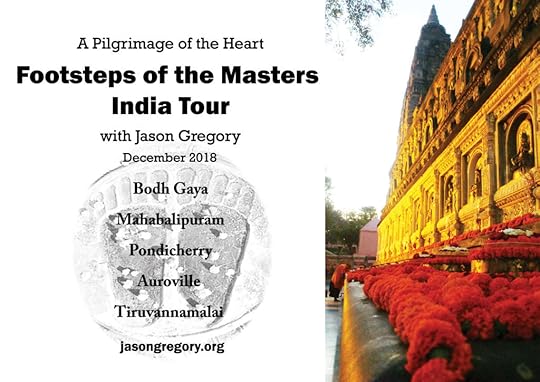
FOOTSTEPS OF THE MASTERS INDIA TOUR
with Jason Gregory
December 3-15, 2018
In 2017 you can travel with author and teacher of Eastern philosophy Jason Gregory on a mystical tour of India to explore and trace the Footsteps of the Masters . Get unique insights into Jason’s knowledge of the East and the memory of the masters and scared places we will visit. Jason wishes to take people to the most sacred places of India to show that the ancient Hindu and Buddhist cultures are thriving but can only be experienced by those willing to join him on this pilgrimage of the heart.
1. About our tour to India:
Our 13-day itinerary includes visits to the most beautiful and mystical places in India. We will travel through India to visit the most important sacred places of Indian history. Most people never get the chance to experience face to face the archaic origins and sites of Hindu and Buddhist culture because they are in some of the most remote places of India. But on this journey you will get that once in a lifetime opportunity to actually feel the ancient living culture that is still thriving in the sacred places we will visit. You will also get the chance to meet real life mystics and mingle with the beautiful people of India.
What is more, during the tour you will take part in private lectures given by Jason Gregory. He will show us the significance of how Eastern thought can help us live more harmoniously in the modern world. He strongly believes that the mystics of the East who expounded especially the Hindu philosophy of Vedanta, Zen in Buddhism, and Taoism are advanced philosophical and spiritual frameworks that give us understanding and guidance in our ordinary lives. And this is the reason for joining Jason Gregory on his tour to India to follow the Footsteps of the Masters. This will be a once in a life-time experience, this tour may never happen again!
Jason Gregory about our India tour:
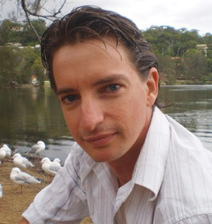 “I have spent several years in India and the experience has changed the entire course of my life. I continue to go back and visit every year, especially the Tamil Nadu and Bihar states as they include the two places in the world that I believe everybody should visit, Tiruvannamalai and Bodh Gaya, and we will be visiting both places on this tour.
“I have spent several years in India and the experience has changed the entire course of my life. I continue to go back and visit every year, especially the Tamil Nadu and Bihar states as they include the two places in the world that I believe everybody should visit, Tiruvannamalai and Bodh Gaya, and we will be visiting both places on this tour.
I have always told people that India is hard to explain, the attraction people have to it, and its transformative ability on an individual. It is a place that most people dislike because of real life hardships that people witness in her. But I have always implored people to persevere with her grace because if you can get past all the things that push you out of your comfort zone, there is an underlying essence of spirit that is only found in India, but you need to give her time and be open to new experiences. Many believe this comes from thousands of years of people focused on the inner realm of spirituality that has led to many great sages and stories of enlightenment in India. On this tour I want to allow people to experience this living spirit that we feel when we are in the culture of India by following the footsteps of the masters. My experience of living in India for several years allows me to take you on an insider’s journey of India on this tour where you will come face to face with her archaic soul.”
Jason Gregory is a spiritual philosopher, independent scholar, author, writer, public speaker, and teacher specializing in the fields of Eastern philosophy, Western esotericism, comparative religion, psychology, culture, and ancients civilizations. He is the author of the highly acclaimed Effortless Living, Fasting the Mind, Enlightenment Now, and The Science and Practice of Humility. Jason spends his time traveling, writing, and teaching around the world through his lectures and workshops centered on his work. His lectures and workshops are said to be one of the most insightful and inspirational events one can attend, as he reveals through his work that enlightenment is not an end goal that we are searching for, but instead a way of life which is an art of living. This understanding leads to the essence of his work that enlightenment evokes a humility which is a universal science.
2. ITINERARY
Day 1 – Arrival to New Delhi (December 3, 2018)
Arrival at Indira Gandhi International Airport. A representative of “One World Within Tours” company will welcome our guests at the Indira Gandhi International Airport and transport them to our hotel. After the check-in process at the hotel, our guests will have time to rest. In the evening we will have dinner and an organizing meeting with “One World Within Tours” company’s staff. Overnight stay at the hotel in New Delhi.
Day 2 – Travel from New Delhi to Bodh Gaya (December 4, 2018)
We will leave our hotel in New Delhi in the morning and we will fly to Patna, the capital city of Bihar. We will then travel by private bus from Patna airport to Bodh Gaya in the afternoon.
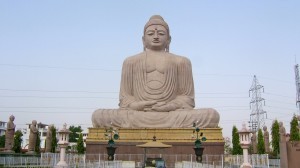
Day 3 – Bodh Gaya (December 5, 2018)
 Bodh Gaya is considered one of the most sacred places on the planet. It is famously known as the place where Gautama the Buddha reached enlightenment under what became known as the Bodhi Tree. Over millennia temples and monasteries have been built around the famous Bodhi Tree. The Mahabodhi Temple and Bodhi Tree reside on the same site and is one of the most powerful places one could visit. It is a holy place for Buddhists, Hindus, and people who are not affiliated with no religion but class themselves as spiritual.
Bodh Gaya is considered one of the most sacred places on the planet. It is famously known as the place where Gautama the Buddha reached enlightenment under what became known as the Bodhi Tree. Over millennia temples and monasteries have been built around the famous Bodhi Tree. The Mahabodhi Temple and Bodhi Tree reside on the same site and is one of the most powerful places one could visit. It is a holy place for Buddhists, Hindus, and people who are not affiliated with no religion but class themselves as spiritual.

On our first day in Bodh Gaya we will rise very early and meditate under the Bodhi Tree and spend a lot of time in the complex of the Mahabodhi Temple discussing its significance to the world.
Day 4 – Bodh Gaya (December 6, 2018)

Again on the second day we will meditate under the Bodhi Tree early in the morning before breakfast. After breakfast we will visit numerous nationalities monasteries that have been built over the millennia in Bodh Gaya.
Day 5 – Travel from Bodh Gaya to Mahabalipuram (December 7, 2018)
This will be a long day of travel. We will leave our hotel in Bodh Gaya in the morning en route to Patna Airport. We will fly from Patna to Chennai. We will then travel by private bus from Chennai airport to Mahabalipuram in the afternoon.
Day 6 – Mahabalipurum (December 8, 2018)
Mahabalipuram (also known as Mamallapuram) is an ancient historic town and was a bustling seaport at the time of Periplus (1st century CE) and Ptolemy (140 CE). Mahabalipuram is one of the most archeologically significant places in India. It is the home of ancient Dravidian architecture where Buddhist elements of design are prominent. In the ancient architecture and art of these sites we see depicted the holy trinity of Shiva, Vishnu, and Brahma along with epic stories that emulate the Bhagavad Gita. The group of monuments at Mahabalipuram has been classifies as a UNESCO World Heritage Site.
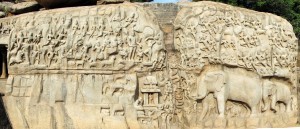
On our second day we will visit the ancient group of monuments at Mahabalipuram where we will discuss the significance of this ancient Indian art. After that we will make our way to the famous Shore Temple and also spend time at the beautiful Mahabalipuram beach.
Day 7 – Pondicherry (December 9, 2018)
 Pondicherry is an old French state of India. It is a beautiful contrast where East meets West. This unique mix of French with Indian thought has led to one of the most culturally diverse states in India which is visable through its architecture and the unification of European ecology with Indian spirituality. This state was home to the 20th century sage Sri Aurobindo and Ponicherry is where he met Mirra Alfassa (also known as “the Mother”), a French woman who was significant in helping Aurobindo’s vision of the unification of a spirituality in harmony with the planet. This vision of the Mother and Aurobindo manifested as the first universal city Auroville just outside Pondicherry. This is where the principles they envisioned for humanity can be recognized. Auroville was founded by the Mother in 1968.
Pondicherry is an old French state of India. It is a beautiful contrast where East meets West. This unique mix of French with Indian thought has led to one of the most culturally diverse states in India which is visable through its architecture and the unification of European ecology with Indian spirituality. This state was home to the 20th century sage Sri Aurobindo and Ponicherry is where he met Mirra Alfassa (also known as “the Mother”), a French woman who was significant in helping Aurobindo’s vision of the unification of a spirituality in harmony with the planet. This vision of the Mother and Aurobindo manifested as the first universal city Auroville just outside Pondicherry. This is where the principles they envisioned for humanity can be recognized. Auroville was founded by the Mother in 1968.

When we arrive on our first day in Pondicherry, we will visit the Sri Aurobindo Ashram and share a meditation together beside the tomb of Sri Aurobindo. After that we will explore the French district of Pondicherry.
Day 8 – Auroville (December 10, 2018)
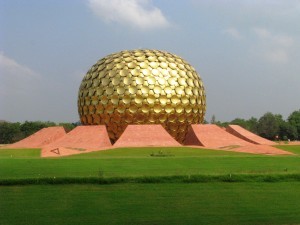
On day 2 in Pondicherry we will rise early and make our way out to the universal city Auroville. We will visit the farms and taste the local organic food in Auroville. After that we will visit the Auroville community centre to learn more about the principles and practices that Sri Aurobindo and the Mother had envisioned for humanity. At the end of the day we will visit the Matrimandir, a golden metallic sphere in the center of Auroville.
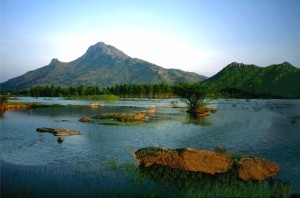
Day 9 – Tiruvannamalai (December 11, 2018)
 Travelling to Tiruvannamalai. Tiruvannmalai is considered one of the most sacred places on Earth. This city has the ability to transform your life. It is known as the City of Enlightenment for that very reason. It has been the home to sages, sadhus, and yogis for thousands of years. Tiruvannamalai is home to the holy mountain Arunachala which is thought of to be an incarnation of Shiva. Arunachala is what drew the 20th century sage Sri Ramana Maharshi to this little Indian town, where he remained silent for 7 years up on the holy mountain in meditation. During his life at the foot of Arunachala disciples were attracted to his immense presence and an ashram was built around him, the famous Sri Ramana Asramam. It was here that Paul Brunton had his famous encounter with the Maharshi and consequently led to his international bestseller In Search of Secret India. The ancient Hindu culture has never left this place, where you find sadhus descend on Tiruvannamalai every day renouncing the world to be at the foot of Arunachala and to also spend time in meditation at the Arunachaleswarar Temple (Temple of Shiva).
Travelling to Tiruvannamalai. Tiruvannmalai is considered one of the most sacred places on Earth. This city has the ability to transform your life. It is known as the City of Enlightenment for that very reason. It has been the home to sages, sadhus, and yogis for thousands of years. Tiruvannamalai is home to the holy mountain Arunachala which is thought of to be an incarnation of Shiva. Arunachala is what drew the 20th century sage Sri Ramana Maharshi to this little Indian town, where he remained silent for 7 years up on the holy mountain in meditation. During his life at the foot of Arunachala disciples were attracted to his immense presence and an ashram was built around him, the famous Sri Ramana Asramam. It was here that Paul Brunton had his famous encounter with the Maharshi and consequently led to his international bestseller In Search of Secret India. The ancient Hindu culture has never left this place, where you find sadhus descend on Tiruvannamalai every day renouncing the world to be at the foot of Arunachala and to also spend time in meditation at the Arunachaleswarar Temple (Temple of Shiva).

On the first day we will visit Arunachaleswarar Temple (Temple of Shiva) and explore its magnificent architecture and mythology. We will tour the city of Tiruvannamalai to get people acquainted with the City of Enlightenment.
Day 10 – Tiruvannamalai (December 12, 2018)
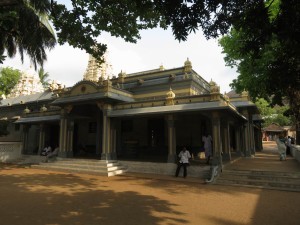
Early in the morning we will go to Sri Ramana Ashram to observe Puja (Hindu ritual worship to any particular God) and also meditate in the silence of this sacred space. We will then walk up to Skanda Ashram where Sri Ramana Maharshi spent 7 years in silence. We will practice meditation there before going to breakfast. Later in the day we will visit the famous Girivalam Path to visit temples and be in the presence of sadhus.
Day 11 – Tiruvannamalai (December 13, 2018)
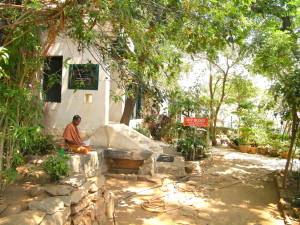
We will rise early again on day 4 to walk up Arunachala and visit Skanda Ashram one last time to meditate before we embark on our day. During our last day in Tiruvannamalai we will visit the Sri Ramana Ashram library to explore numerous scared books for purchase at extremely low prices before saying goodbye to our sadhu friends at Girivalam Path.
Day 12 – Travel from Tiruvannamalai to Chennai (December 14, 2018)
We will leave our hotel in Tiruvannamalai in the morning and travel to Chennai by private bus. We will stay overnight in Chennai to rest and prepare our trip back home.
Day 13 – Depart Chennai (December 15, 2018)

It is time to say goodbye to India. After breakfast we will be flying back to our homes.
The order of places that we are going to visit might be modified.
3. Terms & Conditions
* Price per person: $3800 USD (or equivalent in GBP/EUR/AUD) for double room.
* Couple Special: $6500 USD (or equivalent in GBP/EUR/AUD) for 2 people to share double room.
* After August 15, 2018 deposit or full payment are nonrefundable. This refund policy is in place because from August 15, 2018 all accommodation and traveling schedule will be booked. There will be no refund after August 15, 2018 as a result.
Price Includes:
* Jason Gregory as your tour host
* 12 nights accommodation at good hotels in India
* Dehli to Bodh Gaya domestic flights
*Bodh Gaya to Chennai domestic flights
* Transfers in air-conditioned bus
* Entrance tickets to all sites
Not Included:
* International flight to India and return flight back to your country;
* Domestic flight from the last destination of Chennai back to whatever airport you are leaving India from.
* Visas and insurance. The onus is on the traveler to ensure that passports, visas and other travel documentation are valid and in order.
* Meals during the tour
4. Payment Schedule:
* Only $1000 USD deposit during booking for a single ticket (or equivalent in GBP/EUR/AUD).
* Only $2000 USD deposit during booking for a couple ticket (or equivalent in GBP/EUR/AUD).
* Full payment must be received by 15 August 2018.
* After August 15, 2018 deposit or full payment are nonrefundable. This refund policy is in place because from August 15, 2018 all accommodation and traveling schedule will be booked. There will be no refund after August 15, 2018 as a result.
During booking you should prepare personal details, date of birth, address, phone number, email address, passport number, Passport Expiration Date (example mm/dd/yyyy). These details you should send to our Email: jasongregory@hotmail.com.au
To purchase tickets hit this link: https://www.eventbrite.com/e/footsteps-of-the-masters-india-tour-2018-with-jason-gregory-tickets-27567304550
We encourage you to book this tour as soon as possible, because the number of places is limited!
Please contact us for more information and for details – jasongregory@hotmail.com.au
August 24, 2017
Fasting the Mind Retreat November 10-21, 2018
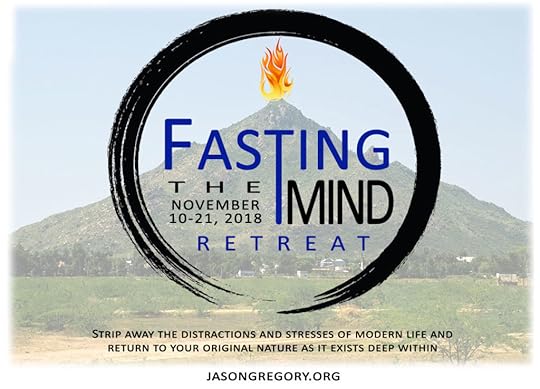
About the Fasting the Mind Retreats
The fasting the mind retreat directly impacts your habits and way of being in the world to create peace and calmness in your life as well as allow you to build a firm psychological defense against the increasing bombardment of distractions in our world. The retreats are held by philosopher and spiritual teacher Jason Gregory. The retreat is designed to fast your mind, healing the mind at the root level. The ancient practice of fasting the mind is based on the great spiritual traditions from the East. Fasting the mind is completely different to fasting the body. Fasting the mind is about eliminating all external distractions from your life and also your habit to overthink so your mind can reach equanimity, revealing the deeper nature of yourself. The practice of fasting the mind repairs the nervous system and heals cognitive impairment.
The practice of mind fasting is the most skillful method to deal with your subconscious, effecting your action and habits. This ultimately transforms the subconscious to better your life. You will learn the mind fasting practices and daily habits to take back into your everyday life. You will learn how to nourish the four fundamentals of meditation, exercise, diet, and sleep. Jason will give you the tools to cultivate intelligence and harness creativity.
The retreat is designed for everybody because the fasting the mind practice is essential for taking your foot off the accelerator in your actively busy life. The time spent on the fasting the mind retreat is perfect for those who suffer from the busyness of life and also people with mental health issues such as depression, chronic anxiety and stress, and so on. The retreat is for those new to meditative practices and also advanced practitioners. From completely pressing pause on your busy life you begin to heal your mind and reach your full potential. What you will experience on the fasting the mind retreat will permanently impact your life. Are you ready for the ultimate fast?
Retreat Features
* 10 day retreat (Arrive November 10 for orientation and leave on November 21)
* 4 hours meditation a day (40 hours for 10 days)
* 2 hours walking meditation a day (20 hours for 10 days)
* 3 days of complete silence (Day 2, 5, and 8)
* 3 days of intermittent fasting (Only two meals from 12pm-6pm on day 2, 5, and 8)
* Daily Qi Gong before the first morning meditation (Baduanjin qigong)
* Mindful eating during each meal (no speaking or fidgeting while eating)
* Daily lectures by Jason on Eastern philosophy, psychology, cognitive science, and health
* Group discussion after daily lectures
* Harness creativity and sustained focus through the practice of Chinese calligraphy
* 3 meals a day based on a slow-carb vegetarian diet
* Scheduled mindful meal preparations
* Daily tea ceremonies using Taoist tonic herbs (caffeine free)
* Cultivate intelligence through disciplined reading time using fasting the mind source material
* Learn how to prioritize sleep
* A complete digital detox
Retreat Guidelines
* No speaking unless in a group session guided by Jason
* No digital devices or any electronics
* No alcohol or drugs
* No caffeine
* No meat
* No music
* No contact with the outside world, including communication with family back home
Where is the Fasting the Mind Retreat?
The Fasting the Mind Retreat will be held in Tiruvannamalai, India. Tiruvannmalai is considered one of the most sacred places on Earth that has the ability to transform one’s life. It is known as the City of Enlightenment for that very reason. It has been the home to sages, sadhus, and yogis for thousands of years. Tiruvannamalai is home to the holy mountain Arunachala which is thought of to be an incarnation of Shiva. Arunachala is what drew the 20th century sage Sri Ramana Maharshi to this little Indian town, where he remained silent for 7 years up on the holy mountain in meditation. During his life at the foot of Arunachala disciples were attracted to his immense presence and an ashram was built around him, the famous Sri Ramana Asramam. It was here that Paul Brunton had his famous encounter with the Maharshi and consequently led to his international bestseller In Search of Secret India. This Hindu culture has never left this place, where you find sadhus descend on Tiruvannamalai every day renouncing the world to be at the foot of Arunachala and to also spend time in meditation at the Arunachaleswarar Temple (Temple of Shiva). Tiruvannamalai is steeped in the fasting the mind practice and method.
Price and Payment Schedule
* Price per person: $2200 USD (or equivalent in GBP/EUR/AUD)
* Full price or $1000 USD (or equivalent in GBP/EUR/AUD) to secure your place
* Full payment must be received by August 15, 2018
* After August 15, 2018 deposit or full payment are nonrefundable. This refund policy is in place because from August 15, 2018 all accommodation will be booked. There will be no refund after August 15, 2018 as a result.
Price Includes
* Jason Gregory as your retreat teacher
* 11 nights’ accommodation (10 days retreat plus day of arrival and the day you leave)
* All food and beverages on the retreat
* Taxi from Chennai International Airport to the Fasting the Mind Retreat in Tiruvannamalai
Not Included in the Price
* International flight to India and return flight back to your country
* Visas and insurance. The onus is on the retreat guests to ensure that passports, visas and other travel documentation are valid and in order
During booking you should prepare personal details, date of birth, address, phone number, Email address, passport number, Passport Expiration Date (example mm/dd/yyyy). These details you should send to our Email: jasongregory@hotmail.com.au
To secure your place hit this link: https://www.eventbrite.com/e/fasting-the-mind-retreat-november-10-21-2018-tickets-37326035176
We encourage you to book this retreat as soon as possible, because the retreat is designed for only 8 people!
Please contact us for more information and for details – jasongregory@hotmail.com.au
June 26, 2017
The Evolution of Human Cognition | Book Excerpt from Fasting the Mind

As the human species began to move to different locations on the planet, our minds naturally adapted to the environments and circumstances that we confronted. This is highly significant in regard to which parts of the brain were in function and the worldview that was shaped accordingly. This is evident when we explore Asiatic and Western cultures from before the Common Era. When we go back to the first two millennia BCE some of the biggest civilizations were the Greek and Chinese cultures. Due to environmental factors, both civilizations developed cognitively different.
When we explore the evolution of ancient Greece we discover mainly small groups of people spread out along a vast area of the Mediterranean coastline. Living in smaller communities meant that the sustenance for survival was oriented toward more individualistic activities. Hunting, herding, and fishing were the main sources of food and labor that the Greeks were engaged in, and they are very individualistic activities. Contrary to the Greeks, the ancient Chinese civilization evolved around the Yellow River valley of northern China. The ancient Chinese lived in larger communities due to the need for establishing large irrigation systems for rice cultivation. Rice cultivation requires a lot of people and is a collective activity, as we still see today in Asia.
The environmental factors that both cultures encountered determined which part of the brain developed further. In ancient Greece life was oriented more toward individualism as a result of the environment. This individualistic perspective exercises more of the cold cognitive controls in the prefrontal cortex (cold cognition (known also as System 2) is the self-conscious, slow, deliberate, and effortful part of our mind, which we refer to as our self, the “I,” found in the prefrontal cortex (PFC), which is the cerebral cortex that covers the frontal lobe of the brain). As a result people began to be increasingly analytical, not because the people were naturally like that, but because that was what was required to sustain life due to the environment. This tendency toward the function of the cold cognitive controls was the seed of the Western psychological trait of analysis. The Western analytical perspective has become the primary cognitive response to life around the world. Beginning in the West, as a result of analytical thinking, everything is dissected, unpacked, and pulled apart in the hope of always coming to a logical conclusion. Yet we are blind to the fact that our logical conclusions are based on our conditioning, which is subjective and not objective.
This analytical view has influenced the modern world tremendously, starting in ancient Greece. The Western view of the universe, God, society, and culture is almost always analytical. The analytical view gave birth to linear thinking, which corrupted Western institutions. For example, Western religions take on a very linear and authoritarian view of God as an egotistical ruler, which results in a political view of the universe, rather than a more natural view. The idea that God created this world and we are subject to him as a king comes from the analytical view of how individuals apply themselves to life. This means we think of a universe that is created, in the same sense of how we build a home: from the outside as an external agent. Western religions think of God in this way, and it has influenced most Western religions deeply. For example, Jesus was the son of a carpenter and also the son of God, and both are seen as builders.
The cold analytic view is attracted to what stands out rather than the relationships of the background to the foreground. Western thought tends to dissect and categorize anything—God, for example—making it the pinnacle of thought, without realizing that if you highlight one object you exclude the rest, which ultimately implies duality rather than the oneness of God. Because of analytical thinking those in the West divide the world into opposites that are separate and isolated. God and humanity are opposites, likewise black and white, female and male, and so on. This way of thinking is completely opposite to that of the East and many indigenous cultures.
There is psychological evidence to prove this difference. Research shows that when Westerners and Easterners are shown the same images they each describe different features and focus on different aspects. For example, one of the better-known research tools is a picture that shows a large object in the foreground and a background composed of smaller objects. One such image shows a big fish in the front while the background is composed of much smaller fish and coral (see figure 1).

Figure 1. The differences between foreground and background.
By Dao Stew.
Looking at this image in the research laboratory, a group of Westerners and Easterners were asked what they see. The majority of the Westerners described the big fish in the foreground, showing little or no awareness of the background. The majority of the Easterners, on the other hand, described the background and its relation to the foreground. This same test has been done many times with similar results. The conclusion of such research illustrates that Westerners are cognitively conditioned to perceive things that stand out due to analytical thinking, which results in a tendency to divide life into categories and objects. The Easterners, on the other hand, are cognitively oriented toward perceiving the world holistically, likely resulting from the collective tendency to perceive life through context and relationships. Both of these different perceptions of life gave birth to the social, cultural, and spiritual philosophies that Easterners and Westerners tend to unconsciously uphold. As Richard E. Nisbett states:
So long as economic forces operate to maintain different social structures, different social practices and child training will result in people focusing on different things in the environment. Focusing on different things will produce different understandings about the nature of the world. Different worldviews will in turn reinforce differential attention and social practices. The different worldviews will also prompt differences in perception and reasoning processes— which will tend to reinforce worldviews.
Focusing on relationships and context is a hallmark of Eastern thought. This Eastern view naturally came about because of the environmental factors, which were mainly community driven in the East. For example, in ancient China what was good for me on a personal level was not necessarily good for the community. And because the main source of food was rice, it was not beneficial for everyone to pursue personal interests. Social harmony was imperative in those times, over and above egocentric desires. As a result the cold cognitive functions were not overly employed because the naturalness of the hot system took over the individual, and so the community could work in unison (hot cognition (known also as System 1) is the function of our mind and body that is automatic, spontaneous, fast, effortless, mostly unconscious, and thought to be emotionally driven. The hot system is found in the more primal part of the brain, which developed earlier in human evolution and which we associate with the unconscious).
Over time this hot cognitive approach to life led to the holistic perception of the world. The holistic view comes from always considering what is best for the greater whole at the expense of your own interests. The holistic view is a state of consciousness that is always mindful of the big picture, while the analytical view keeps us blind to the big picture because it is lost in the detail of one’s own mind and circumstances that are driven by our personal agenda.
The philosophies and spiritual traditions that result from the more holistic Eastern perception of life, such as Hinduism, Buddhism, Taoism, and Confucianism, tend to reflect the view of the totality and how important it is to act in accord with the greater perspective, be that Brahman/Tao, society, or what have you. The wisdom traditions are then based on mutuality and a sense of mystery rather than thinking we know everything. One idea prevalent in the Eastern wisdom traditions is that opposites are mutual, and in their deepest essence one and the same. For example, God dwells in humanity. Also, there is no beginning of night and day, as they are one process. The Chinese concepts of yin (feminine, receptive, earth, cooling energy) and yang (masculine, active, heaven, hot energy) are only apparent opposites when we compensate for one over the other, but when they are in balance we discover their intrinsic unity. Even when we start out in the womb we are all the same. We can’t see this obvious reality when we are overly dependent on the analytical cold cognition. To overuse the cold analytical cognition will exhaust you physiologically, causing the hot system to take over to compensate, taking the “I,” the sense of self, out of the equation. As we become exhausted, we loosen our grip on the daily dramas of life and lose our apparent control so that the unconscious wisdom of the universe can take over. In losing control you gain the kind of control you were always after, which is divinely powerful. This is the wisdom of the East.
That power arises from the unconscious regions of the brain, which are the regions of the brain that were primarily in use in ancient China that results from the collectivist environmental factors. Not many sages, philosophers, and deep thinkers, except for political leaders and royalty, were self-interested in the ancient East because that led to selfishness and the illusion of a personal identity. In both ancient times and today the problems and suffering in the world come from the same place: the wrong perception of an “I” separate from the universe. The idea of the person that you think you are eclipses your understanding that you are one with the universe as the universe. Our mind is plagued with contents that we identify with, without sensing the pure awareness deep within that we truly are.
When we think of “I” we are only thinking of the cold cognition, the troubleshooter that scans the environment for obstacles based on our conditioning, what Chuang-tzu would call the human flaw of qing (qing means “species-specific essence,” and in relation to humans it means the “ability to discern between this and that,” which Chuang-tzu believes is a fundamental flaw). Since our fundamental problem in ancient times is the same as today, both ancient and modern sciences can be combined in understanding the framework to eventually downregulate the sense of “I.”
Buy Fasting the Mind:
Amazon US https://www.amazon.com/dp/1620556464/
Amazon UK https://www.amazon.co.uk/dp/1620556464/
Amazon Canada https://www.amazon.ca/dp/1620556464/
Direct from Inner Traditions https://www.innertraditions.com/fasting-the-mind.html
Direct from Simon & Schuster http://www.simonandschuster.com/books/Fasting-the-Mind/Jason-Gregory/9781620556467
Branes & Noble https://www.barnesandnoble.com/w/fasting-the-mind-jason-gregory/1124693189
The Ancient Eastern Science of the Nervous System | Book Excerpt from Fasting the Mind
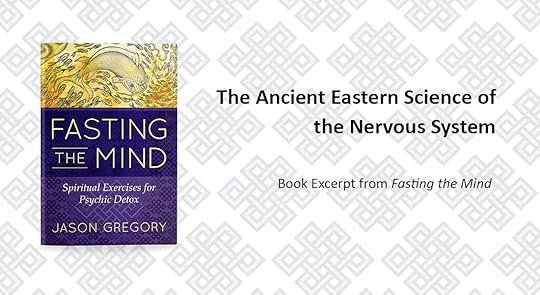
The spiritual path of Buddhism came into existence as a result of this yearning to completely slow down our nervous system so we can experience real freedom. In Sanskrit such freedom is called nirvana, meaning extinction, freedom from suffering, and ultimately the unconditioned eternal reality that we experience as enlightenment. In the story of Gautama the Buddha, he sought methods of practice and philosophy that would evoke the state of nirvana. He followed asceticism and strict spiritual practices for six years. It wasn’t until he was exhausted in his efforts that he finally took some milky soup from a young girl herding cattle and sat under the famous Bodhi tree in the small town of Bodh Gaya, India. In doing so, he completely relaxed without the need for striving. His original efforts had been futile because he was approaching enlightenment in the same way that we purchase a cheap suit. In striving for anything, there is still agitation in the mind, and this perception of life comes from the ignorant view of how we supposedly achieve things in this world.
Whether knowingly or unknowingly, Gautama the Buddha accessed a part of our nervous system that remains dormant when we are always in physical and mental motion. This part of our nervous system is known as the parasympathetic nervous system (PSNS).
To gain a better understanding of this we need to know what makes up the nervous system. The nervous system is the part of an animal’s body that coordinates its voluntary and involuntary actions and also transmits signals to and from different parts of its body. In vertebrate species, such as human beings, the nervous system contains two parts, the central nervous system (CNS) and the peripheral nervous system (PNS). The central nervous system contains the brain and spinal cord, while the peripheral nervous system consists of mainly nerves, which are enclosed bundles of long fibers, and axons, which are long, slender projections of nerve cells that conduct electrical impulses away from the neuron’s cell body. These nerves and axons connect the central nervous system to every other part of the body. The peripheral nervous system is divided into the somatic nervous system (SoNS) and the autonomic nervous system (ANS).
The autonomic nervous system is our central focus when related to psychological or spiritual inner work and transformation. The autonomic nervous system is a control system that largely acts unconsciously and regulates our bodily functions such as heart rate, respiratory rate, digestion, pupillary response, urination, and sexual arousal. The autonomic nervous system has two branches: the sympathetic nervous system (SNS) and the parasympathetic nervous system (PSNS). The sympathetic nervous system is sometimes considered the “fight or flight” system because it is activated in cases of emergencies to mobilize energy. It is what we activate when we are in motion and being stimulated through our senses. Without it we could not do anything. The parasympathetic nervous system, on the other hand, is often considered the “rest and digest” or “feed and breed” system because it is activated when we are in a relaxed state. We activate the parasympathetic nervous system when we essentially do nothing. It is also responsible for stimulation of “rest and digest” and “feed and breed” activities that occur when the body is at rest, especially after eating, including sexual arousal, lacrimation (tears), salivation, urination, digestion, and defecation. The parasympathetic nervous system is what makes us drift off to sleep every night. It is stimulated most when we relax deeply.
The war on our nervous system is essentially the overstimulation of our sympathetic nervous system along with an understimulation of the parasympathetic nervous system. When we stimulate only the sympathetic nervous system without activating the parasympathetic nervous system, we increase the probability of chemical imbalances in our brain from not having a healthy balanced lifestyle. Because of this, the vast majority of us are teetering on the edge of psychological suicide.
People may say in response to this statement that they have time to relax every day. But are our methods for relaxation really relaxing? Our perception of relaxing is sitting in front of the television or computer, playing with our phones, chatting with friends, and so on. This is not true relaxation. Actually, when we engage in such activities we are still stimulating the sympathetic nervous system and not the parasympathetic nervous system. Accessing the parasympathetic nervous system requires a complete shutdown and withdrawal of the senses and mental activity, known as pratyahara in Sanskrit. This shutdown is important to Hinduism, Taoism, and especially Buddhism with its methods of practicing meditation.
No matter whether it is Theravada, Mahayana, Vajrayana, or Zen, the various strands of the Buddha’s teachings have at their core the necessity of starving or fasting the mind. This is done to allow the parasympathetic nervous system to play its role within our psychosomatic organism. One of the more effective methods that the Buddha supposedly taught was vipassana. Vipassana is a Pali word (vipasyana in Sanskrit) used in the Buddhist tradition that means “insight into the true nature of reality.” The meditation practice of vipassana is an ancient method that is believed to have come from Gautama the Buddha himself and which survived through other Buddhas throughout history. Vipassana meditation is thought of not only as a meditation practice in all life but also a disciplined technique that is supposed to evoke vipassana in all life. This technique was reintroduced by Burmese Theravada Buddhist teachers Ledi Sayadaw and Mogok Sayadaw. It was then popularized by Mahasi Sayadaw (a Burmese Theravada Buddhist monk and meditation master), Saya Gi U Ba Khin (the Burmese vipassana meditation teacher and an influential leader of the vipassana movement), and his student, Satya Narayan Goenka (better known as S. N. Goenka), who is well known for spreading the vipassana movement worldwide with more than a hundred centers located in various countries around the world.
The vipassana meditation technique is like shock therapy for your nervous system, consisting of a ten-day course in seclusion away from worldly distractions, where you meditate for hours each day, eat small portions of vegetarian food, and sleep, with no talking at all for the whole duration. The effect this has on us is immense. During the ten days people are finally giving themselves the chance to allow the parasympathetic nervous system to function without the interference of the sympathetic nervous system habitually seeking stimulation. The result is that a lot of the subconscious content lying dormant within our nervous system—content that drives our unconscious reactions and responses to the world—rises to the surface of our conscious mind, giving us the opportunity to finally reveal and heal our deep-seated conditioning.
Vipassana meditation practitioner William Hart explains how we can use “right awareness” and the awareness of respiration (anapanasati in Pali and anapanasmrti in Sanskrit) to bring us back into the ultimate reality of the here and now. He shows how, through the awareness of respiration we can start observing the normally unconscious autonomic functioning of the psychosomatic organism. In Hart’s book The Art of Living: Vipassana Meditation he states:
Focusing on breathing can help us explore whatever is unknown about ourselves, to bring into consciousness whatever has been unconscious. It acts as a bridge between the conscious and unconscious mind, because the breath functions both consciously and unconsciously. We can decide to breathe in a particular way, to control the respiration. We can even stop breathing for a time. And yet when we cease trying to control respiration, it continues without any prompting.
For example, we may begin by breathing intentionally, slightly hard, in order to fix the attention more easily. As soon as the awareness of respiration becomes clear and steady, we allow the breath to proceed naturally, either hard or soft, deep or shallow, long or short, fast or slow. We make no effort to regulate the breath; the effort is only to be aware of it.
Observing our conscious, intentional breath leads us to awareness of the normally unconscious, autonomic function of our natural breath. This meditation on the breath guides us beyond superficial reality toward an awareness of a subtle reality, while the illusion of past and future eclipses this awareness of a subtle reality. Human suffering stems from the looming anxiety of the future and the stress from our past experiences. This temperament has us obsessing about ourselves in an unconscious “me, me, me”–centered attitude. As a result our mind is often lost in the fantasies and illusions of the past and future, where we hold on to pleasant experiences while trying to erase unpleasant experiences of the past, without realizing that both will stay dormant within the subconscious if they are not brought to the surface of consciousness.
When we are mindlessly out of sync with the here and now we are unaware of the cravings and aversions that our subconscious continues to fuel and that drive our unconscious reactions toward the world. Anapanasati is an advanced method that will deliver us from this dilemma of suffering and the perpetual subconscious obsession we have about ourselves. The awareness of respiration, especially if practiced earnestly throughout our life, will allow us to be ever present in the here and now effortlessly, without the need for trying. But this might not be the case in the beginning because we have become accustomed to distraction over the course of our lives. Some effort, then, is necessary at the start of disciplining our attention to be focused in the present moment.
Vipassana is a flawless method for digging into the unconscious material within our mind to give us a glimpse of our true nature. The only problem with this method of fasting the mind is what to do with it when we come out of seclusion and return to the world. American mythologist Joseph Campbell called this “bringing back the boon,” referring to anybody who chooses to break away from fear to embark on the “hero’s journey” and then return to the world to share what they have learned. Campbell explains:
The whole idea is that you’ve got to bring out again that which you went to recover, the unrealized, unutilized potential in yourself. The whole point of this journey is the reintroduction of this potential into the world; that is to say, to you living in the world. You are to bring this treasure of understanding back and integrate it in a rational life. It goes without saying, this is very difficult. Bringing the boon back can be even more difficult than going down into your own depths in the first place.
Many people who come out of a vipassana course often fall straight back into familiar habits when they return to their usual surroundings. The constant practice of fasting the mind hasn’t taken root yet because people fall back into the habit of excessive stimulation. When we get back into that habit we begin to overuse the sympathetic nervous system again. Few people, no matter whether they have done a vipassana meditation course, are conscious of how they consume and transform energy taken in through the nervous system.
Buy Fasting the Mind:
Amazon US https://www.amazon.com/dp/1620556464/
Amazon UK https://www.amazon.co.uk/dp/1620556464/
Amazon Canada https://www.amazon.ca/dp/1620556464/
Direct from Inner Traditions https://www.innertraditions.com/fasting-the-mind.html
Direct from Simon & Schuster http://www.simonandschuster.com/books/Fasting-the-Mind/Jason-Gregory/9781620556467
Barnes & Noble https://www.barnesandnoble.com/w/fasting-the-mind-jason-gregory/1124693189



